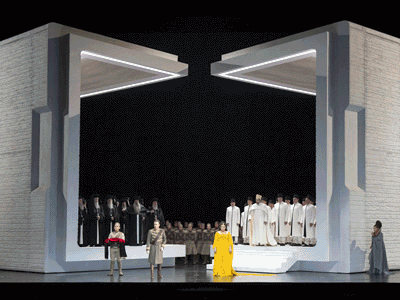
By ANDREW POWELL
Published: August 30, 2017
SALZBURG — Qualitative upticks at the main festival here have heralded Markus Hinterhäuser’s installment as Intendant after a shaky two-summer void. The priority, it appears, is music itself over theater or opera, as might be expected from a boss who is also a professional pianist. Hinterhäuser is retaining the Ouverture spirituelle, a costly 2012 innovation of predecessor Alexander Pereira that ensures a big window for sacred music, and he is returning strength to the chamber-music slate. In a newly staged Aida and a fresh take on La clemenza di Tito this month, the pleasures were musical alone.
Riccardo Muti prepared and led the Verdi, heard at the Großes Festspielhaus fortuitously on Aug. 16 when Anna Netrebko and Daniela Barcellona faced off as the princesses — graduates of Donizetti and Rossini, respectively, and both rich of tone, secure, unstinting, and able to wield the Italian text to exact expressive purpose, generating sequences of actual drama.
One such occurred in the first scene. Barcellona’s Amneris hurled out the imperative Ritorna vincitor! with enough power and point to spin all of Act I around these two words. Muti’s forces — the Vienna State Opera Chorus and the Vienna Philharmonic — emblazoned the mandate with thunderous intensity, leaving Netrebko’s Aida to wanly echo it not as some affront, as many do, but as reason to fear. Her scena rose naturally from the thought, shaped with clear words, dark rumination, ravishing high notes, wondrous floats — this was a steadier performance than for the Aug. 12 video-stream — culminating in a Numi, pietà that would have melted the heart of the stoniest deity, before she promptly vanished, ovationless, as Verdi instructs.
Barcellona’s own brilliant highs and roundness of sound in the middle octave produced exciting duets and ensemble work. A tall actress, she regally commanded her scenes yet managed to convey vulnerability, and in Act IV she slid poignantly from bitterness to remorse — a woman, never the fire-eater — so that the dwindling string parts seemed to trace her fate as much as those of Aida and Radamès, closing the opera perfectly.
Probably the credit belonged with Muti for that last feat, and certainly the sensitive legato in Francesco Meli’s work as Radamès suggested keen preparation, an improvement on his Manrico here two summers ago (when Gianandrea Noseda conducted). Meli sounded best after Act I, his heady metallic timbre acquiring plushness as the action progressed, but he sang with elegance of line all through.
Luca Salsi exuded fatherly authority as Amonasro, sustaining long phrases on a single breath. Dmitry Belosselsky summoned requisite thrust for Ramfis, a stern but precise capo dei sacerdoti, aptly gruff of tone. Most impressive of all, measure for measure, was the true Italian basso of Roberto Tagliavini singing the Rè d’Egitto. Tall like his Amneris, he projected clarion words and mellifluous, weighty tones, apparently without the slightest effort.
After Netrebko’s plea and the brief scene investing Radamès for war — that is, after Act I — the maestro from Molfetta took a full intermission. He had paced this unit of the opera slowly on the whole, at 44 minutes, but had built into it latent strengths, enforcing piani and saying something new with each measure, even in the chanting and dancing, so that Nume, custode e vindice packed more punch than usual and the act could fully balance, not just precede, the one following. An intermission for combat felt only logical.
Out in the lobby, by Café Tomaselli’s (welcome) ice-cream cart, a none-too-sanguine-looking Mariss Jansons engaged in animated chat. The whole crowd in fact seemed stirred if not shaken by the rancor in Memphis. But Aida reverts to human dimensions the moment it has proclaimed its context, and Muti in the next scene elicited the lightest, most mercurial textures for the attendants’ and slaves’ music, choral and orchestral, as if tracing the thoughts of Amneris — leaving Barcellona to gamely play these out on Netrebko.
The conductor supported his singers’ breathing throughout, tending to encourage beauty of phrase and expression. He executed pristine shifts of tempo, tending to inject urgency and sharpen contrasts. He remembered to dance: to honor rhythmic impulses on the instant and ripely characterize them. Best of all, he erred on the side of dynamic restraint, permitting but never urging high decibels.
So this was an Aida on the composer’s terms, nowhere more virtuosic than in its second Thebes scene. Muti finely shaded the women’s and priests’ interludes in the opening Gloria all’Egitto e ad Iside. In the marcia trionfale, what looked like the meter-long, straight, single-rotary-valve C trumpets Karajan used — in place of Verdi’s trombe egiziane in A-flat and B-natural — rang out with immaculate intonation and thrilling antiphony across the gaping stage. The ballabile had infectious rhythm. Salsi’s smooth, obsequious Ma tu, Rè, tu signore possente offset neatly Tagliavini’s grand edicts. The tutti after the priests’ rejection of clemency made its ominous impact, and the Finale’s last section unfolded with tautness.
Each time he entered the pit Muti magnetized attention, and when he trod out it was with the bearing of a mortician, as people roared approval in vanity-stroking counterpoint. But he properly took the remaining three scenes without a formal break, returning in Act III to the stately speeds of the opera’s first two scenes. Netrebko rose to the stipulated dolce high C to conclude O patria mia after conveying that aria’s sense of reflection with exquisite tones, and she and Meli blended tidily for O terra, addio. Barcellona dominated Scene I of Act IV before injecting genuine grief at the close, as noted, to cap a proud Salzburg Festival stage* debut.
Italians in four of the lead roles in this hard-to-cast opera; expert choristers (aided by their confinement to the staging’s Brutalist box structures and by stage-direction prescribing little movement); and Vienna’s orchestra playing with more abandon than for opening night (Aug. 6, as broadcast by BR Klassik) or the video-stream — negating impressions of a musically stilted, dramatically aloof presentation, though these had borne out Muti’s 38-year hiatus from the score and the hiring of a stage director who is really a photographer — reinforced the belief that Salzburg is the one place where ingredients of such quality can come together.
Teodor Currentzis led a vigorous, aurally colorful, not especially elegant traversal of Mozart’s Roman opera Aug. 17 in the Felsenreitschule, with tight support from the Choir and Orchestra MusicAeterna of Perm Opera, or, more precisely, the Choir and Orchestra of Teodor Currentzis. His cast toiled diligently. Golden-toned Golda Schultz acted credibly but sounded overparted as Vitellia in this venue. Marianne Crebassa made a compelling but hyperactive Sesto, not especially sumptuous of voice. She was much cheered after Parto, parto, ma tu ben mio, for the obbligato to which Perm’s clarinetist slunk around her on stage. Reprising a title role he sang at the Met five years ago, Russell Thomas projected his voice with focus and musical authority. The smaller roles of Annio (Jeanine de Bique), Servilia (Christina Gansch) and Publio (Willard White) were adequately sung. At curtain, Currentzis drew wild, really quite bizarre applause, louder than for any cast member.
Neither of the two stagings will be much welcomed going forward. Shirin Neshat’s scheme for Aida, another essay in lens-obedient, firm, gray surfaces that bathe in any light and reflect any color but take us nowhere, features stiff, contrived action hampered and dwarfed by the box structures. Our engagement hinges on costumes, lighting, and initiatives by the singing actors. And Salzburg’s safety curtain more closely evokes Pharaonic Egypt than the commissioned sets. Peter Sellars’ realization of Tito, conversely, has too much fluidity and parades a number of old clichés, many of them Sellars’ own. The idea of intravenous infusions for a bedridden emperor proves especially irksome.
[*She and Netrebko sang I Capuleti e i Montecchi at the festival in 2004 under Ivor Bolton, but in concert. Her career is evolving. October, for instance, brings Schumann and Brahms songs at La Scala.]
Photos © Monika Rittershaus (set; Meli with Netrebko), Marco Borrelli (Barcellona; Barcellona with Netrebko), Franz Neumayr (Muti and Netrebko at curtain call)
Related posts:
Muti the Publisher
Muti Casts His New Aida
Nitrates In the Canapés
Verdi’s Lady Netrebko
Mastersingers’ Depression
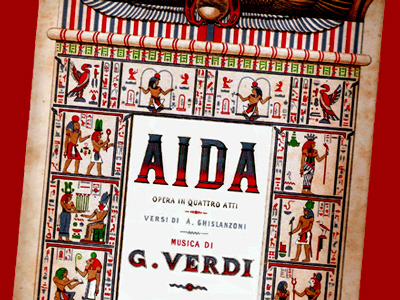
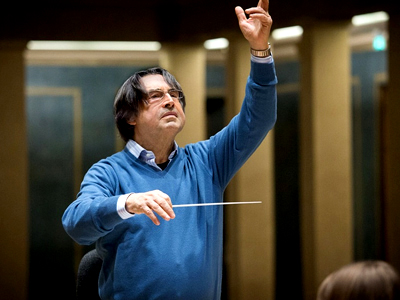
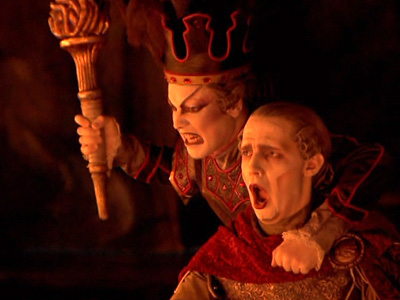
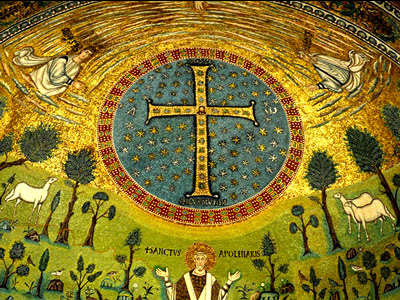
Muti the Publisher
Saturday, October 29th, 2016By ANDREW POWELL
Published: October 29, 2016
RAVENNA — Imprints, sub-brands, and discreet licensing entities were once a way for artists with bargaining power to secure fatter stakes in the published output of their work. Among conductors, Herbert von Karajan, Leonard Bernstein and Nikolaus Harnoncourt enjoyed the privilege.
Are such endeavors still viable, given social media and the glutted commercial market for sound and video recordings? One artist who is surely finding out is Riccardo Muti. Some years ago he set up RMM, or RM Music Srl, here on the neat stone alley linking Dante’s tomb with Teatro Alighieri, main venue of the Ravenna Festival.
This is, sources say, a family business intended to provide income streams into the future for the maestro’s children: Francesco, 45, an architect; Chiara, 43, actress and stage director; and Domenico, 37, laureato in legge and in charge of contracts.
Holding “all the image and recording rights of Riccardo Muti,” no less, RMM produces, publishes, and licenses on its own account and in association with such names as Corriere della Sera and CSO Resound — the former an Italian daily newspaper, the latter a nine-year-old Chicago Symphony Orchestra “response to the upheaval in the music industry.”
Unlike those departed maestros coddled by Bertelsmann, Sony or Universal, Muti is charting an autonomous, probably arduous, path involving rights-retention, brand-building, and deal-adjusted marketing strategies. On its own, RMM lacks clout. In association with others, it must permit assorted offerings and suffer faults in packaging and distribution.
Worthy products bearing RMM’s stamp-like logo face the same hurdles to profitability nowadays confronting the conglomerates, on less publicity. It is practically a secret, for instance, that three new Muti-led Verdi opera recordings arrived on the market this past spring.
Nonetheless RMM operates as cagily as a pure-play licensor, disclosing little online. For this post, it declined an invitation to expound on mission or plans. RCS MediaGroup, which runs the newspaper and calls RMM a “partner,” said it had to confer before confirming the success of a lengthy recent operazione congiunta, and in the end could not.
The conductor began discernibly to tighten control over recordings of his work after Decca’s DVD release of the 2006 Salzburg Die Zauberflöte. This was and remains his last new release on a “major” label, a remarkable halt considering his eminence.
Rights started to move to RMM almost certainly through revised clauses in Muti’s engagement contracts, including those with orchestras, opera companies and festivals whose output is broadcast using public money.
The pace of Muti releases then slowed. In the nine years through last December, only a handful of new orchestral discs appeared, and only three opera issues — a 2008 Salzburg Otello DVD on the lately launched C Major label; a 2011 Otello audio CD set from Chicago; and Mercadante’s I due Figaro, recorded in 2011 for Ducale.
More recently, though, any instinct to restrict supply has given way to pragmatism. RMM products have grown in number despite market conditions. (The glut was not in any case constraining promoters of less bankable artists, or issuers of pirate Muti discs.) Even with these, however, an attractive backlog remains of unreleased broadcast recordings of the conductor’s work.
RMM as a standalone label tends toward specialty discs, many featuring the Orchestra Cherubini, based here. An 11-hour DVD set of orchestral rehearsals, led in Italian and wide-ranging in repertory, will be among the most prized of these long-term. Packaged in saintly white, it sells for €99. Then there is a 100-minute documentary about conducting Verdi; “assolutamente trascinante,” reads one plaudit.
The lineup, RMM-produced, can be sampled and acquired on the company’s website, but not, pointedly, at the ubiquitous online retailer or through channels outside Italy.
Of RMM’s deals, one with Warner Classics presumably earns revenue. The 2013 Verdi documentary, filmed in Chicago and Rome and directed by Gabriele Cazzola, fittingly caps the American company’s new single-box reissue of all eleven of Muti’s former EMI Verdi opera sets. This represents something of a bargain, at about $75, under a dark and piercing RMM cover image.
RMM’s largest project has been with the Corriere’s distribution arm: a €317 collection of 32 Muti titles (roughly 50 CDs) chosen by the artist himself and classically presented in black and bronze. Finalized in August after a 32-week rollout, it carries the banner La musica è la mia vita.
It is also, alas, a jumble. Most of the discs are reissues stretching as far back as 1970s concerto recordings with Sviatoslav Richter and the old Aida with the New Philharmonia Orchestra. Later efforts from Philadelphia and Vienna occupy much space. Inevitably many collectors will already own parts of the set.
Yet hidden in the huge box are three legitimate new Verdi opera recordings that would once have caused a global stir. They originate in strongly cast live performances during the Verdi bicentennial year of 2013 at the Teatro dell’Opera di Roma:
— Nabucco, with Tatiana Serjan (as Abigaille), Sonia Ganassi (Fenena), Francesco Meli (Ismaele), Luca Salsi (Nabucco) and Riccardo Zanellato (Zaccaria);
— I due Foscari, the most recent of seventeen Verdi operas now in Muti’s repertory, with Serjan (Lucrezia), Meli (Jacopo) and Salsi (Francesco); and
— Ernani, with Serjan (Elvira), Meli (Ernani), Salsi (Carlo) and Ildar Abdrazakov (Silva).
Rome’s production of the biblical opera had made news two years earlier when Muti lectured Italy’s politicos — President Giorgio Napolitano and Prime Minister Silvio Berlusconi each attended at least once — on the perils of low cultural subsidies. Halting one performance, he related Italy’s destiny to the “beautiful and lost” Jewish homeland before indulging the house in a leaden Và, pensiero, sull’ali dorate sing-along.
Aptly enough for a newspaper company, Corriere della Sera’s slow rollout took place on newsstands across this country, allowing buyers to skip unwanted titles if they could do without the “unedited little book of [Muti] memories and anecdotes” included in the set.
Cost per title: a modest €10.90, whether one, two, or, for Guillaume Tell in Italian, four discs. News vendors on Piazza dei Caduti and Piazza del Popolo here reported sales of “tanti” discs and “un successo,” evidently freer to speak than RCS MediaGroup.
At the Corriere’s online store, shipping can be arranged worldwide. But product details are missing. Shoppers see only the front covers and a footnote about the recording source. The new Verdi items come up without casts.
With the Chicago orchestra, RMM has weaker terms. The CSO made clear this month that it holds sole copyright in CSO Resound recordings and that RMM’s stamp, present by agreement on five of its published titles, indicates no financial participation by the Muti family entity. Nor is the label intended to function as a profit center within the umbrella CSO nonprofit, the orchestra said.
RMM-branded discs and downloads on CSO Resound are a motley array, no doubt reflecting goals and realities other than Muti’s artistic emphases as Chicago Symphony Orchestra music director.
Issued: a Berlioz pairing of Symphonie fantastique with Lélio, ou Le retour à la vie (2010, much delayed); Schönberg’s Kol Nidre coupled with Shostakovich’s Suite on Verses of Michelangelo (2012, much delayed); Mason Bates’ symphony Alternative Energy and Anna Clyne’s “sonic portrait” Night Ferry (2012); numbers from the first two of Prokofiev’s Romeo and Juliet suites (2013); and Bates’ Anthology of Fantastic Zoology (2015).
Those realities have to do with how orchestras raise funds in the U.S. — meaning conditions or incentives attendant on specific subsidizing grants and gifts — and naturally whether a product is considered saleable. The Zoology item has sold relatively well, the CSO said, without providing figures.
Having no stake, managers at RMM have no reason to care about CSO Resound repertory, but other observers away from South Michigan Avenue — and record buyers — must wonder at the lack of music from the Classical period, where Muti excels. His discerning Schubert, for example. Moreover the CSO would not confirm it will issue the Verdi Macbeth it recorded in 2013, or Falstaff, basketed a few months ago.
As for RMM’s stamp, it appears merely “in support of [Muti] and his wider activities around the world,” explained the orchestra with lawyerly reticence. (It is omitted from two Verdi issues on CSO Resound, the mentioned Otello and a recording of the Requiem Mass made before Muti assumed his post.)
CSO Resound gives RMM visibility Stateside and has good distribution, using multiple online retailers for disc and download versions of most titles.
The label’s packaging, on the other hand, with crude typography and slipshod billing, cannot match RMM products created in Italy. Take the Berlioz disc. Finally released in 2015, five years after being recorded, its cover declares “Chicago Symphony” three times, plus “CSO”; lists the conductor before the orchestra, then the soloists, whose names are separated by a slash, and chorus; and allows the most noteworthy item, Lélio, to get lost essentially.
Muti the publisher, then, faces a host of hurdles. For RMM to be viable, never mind guarantee long-term family income, it needs all elements pulling in its favor. It must balance the pros and cons of independence against those of joint ventures while avoiding unforced errors such as caginess, intentional product delays and narrowed distribution.
At a glance, its best prospects lie in content from tax-supported broadcasts, as newly marketed. WFMT, WQXR, Italy’s RAI and Austria’s ORF have all aired the conductor’s work since 2006, filmed or taped. Standards are high, and in terms of production the output is largely ready for release — ready, but at present held up and falling to pirates.
Listing just operas, and not counting items discussed above, RMM may have “recording rights” in: Il ritorno di Don Calandrino (Salzburg) and Sancta Susanna (New York), from 2007; Così fan tutte and Don Pasquale (both Vienna), 2008; Iphigénie en Aulide (Rome) and Moïse et Pharaon (Salzburg), 2009; Attila (New York) and Orfeo ed Euridice (Salzburg), 2010; Macbeth (Salzburg), 2011; Simon Boccanegra (Rome), filmed in 2012; and Manon Lescaut (Rome), 2014 audio.
There is a solid if limited market on DVD or CD for this body of work, and one instinctively wishes the family venture every success in using the associated rights, even if the era has likely ended when imprints could assure fortunes.
That said, Riccardo Muti’s personal priority may be something else: legacy. His own, and more emphatically the artistic traditions he values. Hence the not necessarily lucrative documenting of preparation and rehearsal methods in RMM productions. It is no coincidence his Italian Opera Academy is headquartered on the same alley.
Images © RM Music Srl and RCS MediaGroup
Related posts:
Muti Taps the Liturgy
MPhil Bosses Want Continuity
Winter Discs
Netrebko, Barcellona in Aida
Concert Hall Design Chosen
Tags:Berlioz, Chicago Symphony Orchestra, Commentary, Corriere della Sera, CSO Resound, Ernani, Gabriele Cazzola, Giuseppe Verdi, Italian Opera Academy, Lélio, Nabucco, Orchestra Cherubini, Ravenna, RCS MediaGroup, Riccardo Muti, RMM, Teatro dell'Opera di Roma, Warner Classics
Posted in Munich Times | Comments Closed